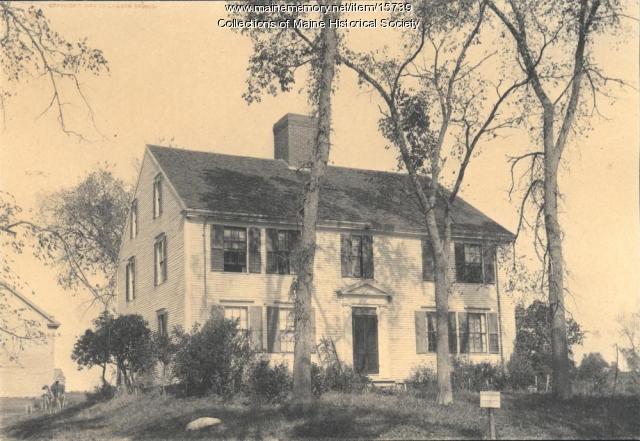Keywords: locale
Item 103932
Christmas party at Central Theater, Biddeford, ca. 1948
Contributed by: Biddeford Mills Museum Date: circa 1955 Location: Biddeford Media: Photographic print
Item 19026
Three-Prong Barrel Hoist, ca. 1910
Contributed by: Presque Isle Historical Society Date: circa 1910 Location: Presque Isle Media: Metal
Item 65229
73-75 Newbury Street, Portland, 1924
Owner in 1924: David Finkelman Use: Apartments
Item 110037
Henry H. Brock building, Alfred, ca. 1905
Contributed by: Maine Historical Society Date: circa 1905 Location: Alfred Client: Dr. Brock Architect: Frederick A. Tompson
Item 110038
Workman's Cottage for Dr. Henry H. Brock, ca. 1905
Contributed by: Maine Historical Society Date: circa 1905 Client: H.H Brock Architect: Frederick A. Tompson
Exhibit
Black soldiers served in Maine during World War II, assigned in small numbers throughout the state to guard Grand Trunk rail lines from a possible German attack. The soldiers, who lived in railroad cars near their posts often interacted with local residents.
Exhibit
Sagadahoc County through the Eastern Eye
The Eastern Illustrating and Publishing Company of Belfast, Maine. employed photographers who traveled by company vehicle through New England each summer, taking pictures of towns and cities, vacation spots and tourist attractions, working waterfronts and local industries, and other subjects postcard recipients might enjoy. The cards were printed by the millions in Belfast into the 1940s.
Site Page
"… Land: The Northeastern Boundary in Treaties and Local Reality, 1763-1842 While national and imperial leaders were pleased with the 1842 border…"
Site Page
"… Land: The Northeastern Boundary in Treaties and Local Reality, 1763-1842 Essay by Liam Riordan Riordan is American historian specializing in the…"
Story
Charles "Chuck" Tsomides: devoted to family and local sports
by Biddeford Cultural & Heritage Center
A life influenced by Greek ancestry, love of music and appreciation for local community sports
Story
History of Forest Gardens
by Gary Libby
This is a history of one of Portland's oldest local bars
Lesson Plan
Longfellow Studies: "The Jewish Cemetery at Newport"
Grade Level: 6-8, 9-12
Content Area: English Language Arts, Social Studies
Longfellow's poem "The Jewish Cemetery at Newport" opens up the issue of the earliest history of the Jews in America, and the significant roles they played as businessmen and later benefactors to the greater community. The history of the building itself is notable in terms of early American architecture, its having been designed, apparently gratis, by the most noted architect of the day. Furthermore, the poem traces the history of Newport as kind of a microcosm of New England commercial cities before the industrialization boom. For almost any age student the poem could be used to open up interest in local cemeteries, which are almost always a wealth of curiousities and history. Longfellow and his friends enjoyed exploring cemeteries, and today our little local cemeteries can be used to teach little local histories and parts of the big picture as well.
Henry Wadsworth Longfellow visited the Jewish cemetery in Newport, RI on July 9, 1852. His popular poem about the site, published two years later, was certainly a sympathetic portrayal of the place and its people. In addition to Victorian romantic musings about the "Hebrews in their graves," Longfellow includes in this poem references to the historic persecution of the Jews, as well as very specific references to their religious practices.
Since the cemetery and the nearby synagogue were restored and protected with an infusion of funding just a couple years after Longfellow's visit, and later a congregation again assembled, his gloomy predictions about the place proved false (never mind the conclusion of the poem, "And the dead nations never rise again!"). Nevertheless, it is a fascinating poem, and an interesting window into the history of the nation's oldest extant synagogue.
Lesson Plan
Longfellow Studies: The Elms - Stephen Longfellow's Gorham Farm
Grade Level: 6-8, 9-12
Content Area: English Language Arts, Social Studies
On April 3, 1761 Stephen Longfellow II signed the deed for the first 100 acre purchase of land that he would own in Gorham, Maine. His son Stephen III (Judge Longfellow) would build a home on that property which still stands to this day. Judge Longfellow would become one of the most prominent citizens in Gorhams history and one of the earliest influences on his grandson Henry Wadsworth Longfellow's work as a poet.
This exhibit examines why the Longfellows arrived in Gorham, Judge Longfellow's role in the history of the town, Henry Wadsworth Longfellow's vacations in the country which may have influenced his greatest work, and the remains of the Longfellow estate still standing in Gorham today.




















